Small Planet Communications, Inc. + 15 Union Street, Lawrence, MA 01840 + (978) 794-2201 + Contact







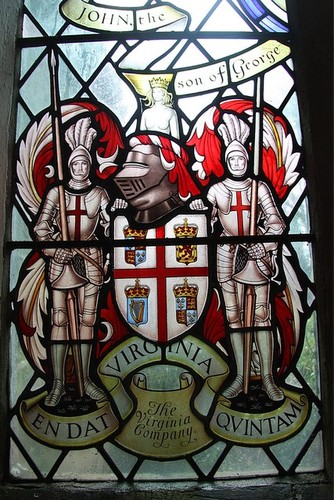
Part of a stained glass window depicts
the coat of arms of the Virgina Company.
Read more about the Virginia Company.
The Spanish were the first Europeans to establish permanent colonies in North America in the 1500s. They had dominated the region since the time of Christopher Columbus. The English had tried, unsuccessfully, to establish colonies of their own to compete with their Spanish rivals. In 1607, England finally got the opportunity when Jamestown, Virginia, became the first permanent English settlement in North America.
Lured to the New World with promises of wealth, most colonists were unprepared for the constant challenges they faced: drought, starvation, the threat of attack, and disease. With the help of stern leadership and a lucrative cash crop, the colony eventually succeeded. In doing so, the colonists paved the way for two powerful institutions that would have far-reaching affects on American government and culture—democracy and slavery.
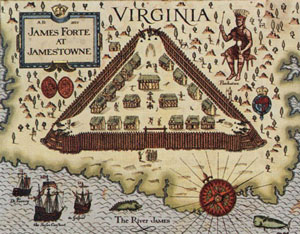
James Fort at Jamestown, 1607. Read more about
the early settlement.
British colonization was set in motion when King James I of England granted a charter to the Virginia Company in 1606. The group was a for-profit, joint stock company given the task of settling Virginia in the New World and providing supplies and ships for the voyage. The company selected Christopher Newport to lead the expedition. In May 1607, Newport brought three ships into Chesapeake Bay and landed approximately 100 passengers on a swampy peninsula along the James River. The settlers built a wooden fort, named James Fort, in an effort to protect themselves from their Spanish enemies.
The settlers were immediately plunged into a struggle for survival. During the first summer, disease took a devastating toll. The colony also endured regular attacks from the neighboring Powhatan Indians. The James River was contaminated with salt water, so those who drank from it suffered from salt poisoning. With the onset of autumn, the settlers found that they did not have enough food to sustain them through the winter. Not enough land had been cleared, nor sufficient crops planted and harvested, because too many settlers had focused their efforts on searching for gold instead.
The situation was alleviated somewhat by the leadership of Captain John Smith, who, in the next twelve months, compelled his fellow colonists to live up to their obligations by planting corn, strengthening their defenses, and building shelters for themselves and their goods. He instituted a policy of strict discipline, telling the colonists, "He that will not worke, shall not eate."
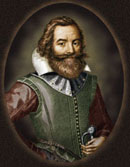
Read a biography of
Captain John Smith.
In December 1607, Captain Smith and a small group of settlers embarked on a mission to explore the area and trade with local American Indians. They were surprised and captured by a Powhatan hunting party, which had led previous attacks on the colonists. All of the men in Smith's party were slain except for Smith himself who was taken to Chief Powhatan, the emperor of the Powhatan tribes. According to Smith's account, as he was about to be executed, Chief Powhatan's daughter, Pocahontas, convinced her father not to kill him. Some historians speculate that Smith mistook an adoption ceremony—where a captive undergoes a symbolic death in order to be saved and "reborn" as an adopted tribe member—for an execution. Other scholars question whether the event took place at all.
In the fall of 1609, Smith was forced to return to England for medical treatment after a gunpowder explosion left him with severe burns. Soon after his departure, relations between the settlers and the Powhatan Indians deteriorated, and hostilities grew. Chief Powhatan attempted to drive the settlers out of the area by starving them. His confederacy stopped trading for food and attacked anyone who ventured outside of James Fort. The position of the colonists was particularly precarious because they were still not self-sufficient and relied heavily on the American Indians for food. The bitter, devastating winter that followed Smith's departure became known as "the Starving Time." Only 60 Jamestown colonists survived to see the spring of 1610. In early June of that year, the remaining settlers decided to abandon the colony. However as they were about to sail out of Chesapeake Bay, they were ordered back by three English ships bringing a new governor, 150 colonists, and an ample supply of food for a year.
The new governor, Thomas West, known as Lord De la Warr, instituted rigorous discipline aimed at making Jamestown self-sufficient. Settlers were expected to work hard or face punishment. Troublemakers were dealt with swiftly and harshly. De la Warr's successors, Sir Thomas Dale and Sir Thomas Gates, followed his example of leadership. Under their authoritarian rule, fields were expanded, better shelters were built, and the settlement slowly began to prosper.
DID YOU KNOW?
In 1616, the colonists
shipped 2,300 pounds of
tobacco to England. Just
two years later, more
than 49,000 pounds
were exported.
Colonist John Rolfe added significantly to Jamestown's prosperity. Around 1612, he began to experiment with growing different varieties of tobacco. The local tobacco plant was extremely bitter, so Rolfe introduced a West Indian variety, which was sweet—like the popular type that England imported from Spain. By 1614, Rolfe had grown enough tobacco to export barrels of it back to England. The reception was sensational and financially profitable. Other colonists soon followed in Rolfe's footsteps. Tobacco quickly became the sole cash crop of a booming economy in Virginia.
During this time, a new development took place between the Powhatans and the colonists. In 1613, Captain Samuel Argall kidnapped Pocahontas. She was taken hostage in retaliation for English prisoners being held by her father, Powhatan, as well as the weapons and tools that had been stolen from the colony. Argall promised to treat Pocahontas well and to release her when her father freed the English captives and weapons. When Chief Powhatan set the English captives free with only some of the guns, Argall demanded that all of the weapons be returned. That day never came, and Pocahontas remained in captivity. During the year that she was held captive, Pocahontas learned English and converted to Christianity. She also met and married John Rolfe, with her father's permission. The marriage resulted in several years of peaceful relations between the American Indians and the colonists.
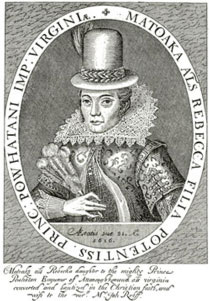
The marriage of Pocahontas to
Englishman John Rolfe brought a
period of peace between the
colonists and the Algonquian tribes.
In 1619, two major developments took place in Jamestown. The first was the introduction of a representative government. The Virginia Company established the General Assembly, the first representative legislature in English America. It was set up much like the present-day United States Senate, with voters from each colony electing two representatives from four cities, or boroughs, within each colony, and seven plantations. In addition to the 22 elected officials, 6 men were appointed by the Virginia Company to serve as advisers. Both the governor of the colony and the Virginia Company itself had veto power. Although it did not have much power, the General Assembly would be a model of self-government that future colonies in North America would look to in forming their own governments.
Unlike the introduction of self-government, the second major development of 1619 had far more negative consequences: the first Africans were brought to Jamestown for the purpose of enslavement. A Dutch ship and a ship out of Jamestown attacked a Portuguese slave ship in the West Indies, capturing about 50 enslaved Africans. Nearly half of the Africans were purchased and remained in Jamestown. Arriving in August, in the middle of the tobacco harvest, probably meant that they were sent to work in the tobacco fields with white servants. Due to a lack of records, it is unclear whether the Africans were the first slaves or if they held the position of indentured servants, who would be eligible for freedom after a given number of years. Substantial historical records of slavery in the English colonies do not appear until the 1640s.
Click to play an interactive
Jamestown Adventure
game, sponsored by
National Geographic Kids.
The period of peace between the American Indians and the colonists was shattered with Powhatan's successor, Opechancanough, in charge. Opechancanough realized that the settlers were not there just for trade; they were intending to live on the land permanently and to continue to expand their land holdings. The peace that came of John Rolfe's marriage to Pocohontas led other Europeans to consider an integration of societies, beginning with Christianizing the native people. The American Indians felt differently, however.
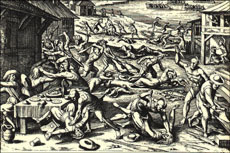
Read more about the 1622
Jamestown Massacre.
On March 22, 1622, Powhatan Indians attacked the smaller English settlements and scattered plantations along the James River, murdering 347 men, women, and children and destroying crops and supplies. In this notorious Jamestown Massacre, roughly one-fourth of the colony's population was killed. Not only did the massacre stun the colonists with such a massive loss of life, but it created a food shortage for the coming winter because the killings occurred just before the planting season, and surviving males were now needed for guard duty. Malnutrition, disease, and additional American Indian attacks were responsible for the deaths of another 400 colonists during the winter of 1622–1623. The colonists would retaliate over the next few years, killing far more American Indians than the number of English who were murdered during the Jamestown Massacre.
The Jamestown Massacre was the final blow for the Virginia Company. James I revoked the company's charter in 1624 and placed Virginia under his control. Thus, Virginia became the first royal colony under the direct rule of the Crown. Nevertheless, the first royal governor and his successors found themselves fairly constrained: they had no soldiers or bureaucracy to fall back on and unclear policies on what to do when problems arose.
Sir William Berkeley succeeded the governorship of Virginia and held this position from 1642 to 1652 and again from 1660 until his death in 1677. Berkeley's second period as governor was marked by trouble. Outside of his circle of confidants, the aristocratic Berkeley was not well-liked. His efforts to convince the colonists to diversify agriculturally failed. American Indian attacks, economic depression, crop failures, and high taxes compounded his problems.
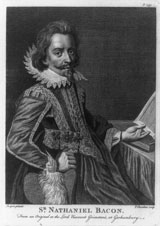
Click to learn more about
Bacon's Rebellion.
Repeated American Indian attacks on the plantations prompted 200 colonists to come together to protect themselves. A young man named Nathaniel Bacon, Berkeley's cousin by marriage, led this volunteer army. Berkeley and Bacon's views on American Indian policy differed greatly: Berkeley wanted to foster trade with the American Indians; Bacon wanted to remove them. When Bacon organized an attack on the American Indians against Berkeley's orders, the governor declared Bacon a rebel and had him arrested. Although Berkeley soon pardoned Bacon, who promised loyalty, he would have to confront him again. This time, Bacon armed himself with men who surrounded the statehouse and threatened violence if he was not allowed to wage war against the American Indians without interference from the government. Berkeley had no choice but to give in. And so began Bacon's Rebellion.
Berkeley, now governor in name only, was forced to turn control of Jamestown over to Bacon in July of 1676. Nathaniel Bacon made his supporters pledge allegiance to him by signing an oath promising to fight against Berkeley as well as any troops sent from England in support of Berkeley. In doing so, Bacon asked his supporters not only to turn against their governor, but to be willing to rebel against King Charles—which was treason. With signatures in hand, Bacon turned his attention to the American Indians once again.
Bacon's rule was short-lived. In September 1676, Berkeley had gathered enough troops to try and retake Jamestown. Bacon built up his own troops by promising freedom to any slave or indentured servant who supported his cause. Bacon won the battle. In doing so, he decided that Jamestown was a threat to him because British troops could land reinforcement troops there. He came to the conclusion that Jamestown needed to be destroyed. On the night of September 19, 1676, Bacon set Jamestown on fire. About a month later, Bacon died suddenly, and Berkeley regained control of the government. Berkeley hanged more than twenty men for taking part in the rebellion. Jamestown never recovered from the fire, and the capital was eventually moved several miles inland to Williamsburg in 1699.
Jamestown | Bibliography
- Christopher Newport University. "About Captain Christopher Newport." Accessed 5/30/19. http://cnu.libguides.com/newport
- The Colonial Williamsburg Foundation. "Captain John Smith." Accessed 5/30/19. http://www.history.org/foundation/journal/smith.cfm
- Encyclopædia Britannica. "Jamestown Colony." Accessed 5/30/19. http://www.britannica.com/EBchecked/topic/300134/Jamestown-Colony
- Encyclopædia Britannica. "John Smith." Accessed 5/30/19. http://www.britannica.com/EBchecked/topic/549779/John-Smith
- Encyclopædia Britannica. "Pocahontas." Accessed 5/30/19. http://www.britannica.com/EBchecked/topic/465632/Pocahontas
- Encyclopædia Britannica. "Sir William Berkeley." Accessed 5/30/19. http://www.britannica.com/EBchecked/topic/62012/Sir-William-Berkeley
- Encyclopædia Britannica. "Thomas West, 12th Baron de la Warr." Accessed 5/30/19. http://www.britannica.com/EBchecked/topic/153686/Thomas-West-12th-Baron-De-La-Warr
- Encyclopædia Britannica. "Virginia Company." Accessed 5/30/19. http://www.britannica.com/EBchecked/topic/347025/Virginia-Company
- Encyclopædia Britannica. "Williamsburg." Accessed 5/30/19. http://www.britannica.com/EBchecked/topic/644431/Williamsburg
- Hume, Ivor Noël. The Virginia Adventure: Roanoke to James Towne: An Archaeological and Historical Odyssey (New York: Alfred A. Knopf, 1994).
- The Mariners' Museum. "Native Americans: Post-Contact: How Was Pocahontas Kidnapped?" Accessed 5/30/19. http://www.marinersmuseum.org/sites/micro/
cbhf/native/nam022.html - National Park Service. "Historic Jamestowne: Bacon's Rebellion." Accessed 5/30/19. http://www.nps.gov/jame/historyculture/bacons-rebellion.htm
- Price, David A., Love and Hate in Jamestown: John Smith, Pocahontas, and the Heart of a New Nation (New York: Alfred A. Knopf, 2003).
- Public Broadcasting Service (PBS). "Death at Jamestown." Accessed 5/30/19. http://www.pbs.org/wnet/secrets/previous_seasons/case_jamestown/
index.html - Quinn, Arthur. A New World: An Epic of Colonial America from the Founding of Jamestown to the Fall of Quebec (Boston: Faber and Faber, 1994).
- Virtual Jamestown. "The Powhatan Indian Attack of March 22, 1622." Accessed 5/30/19. http://www.virtualjamestown.org/phatmass.html
Jamestown | Image Credits
- Coat of Arms of the Virginia Company | Author: unknown; permission of Richard Croft
- James Forte at Jamestowne ~ 1607 | Artist: John Hull, 1607; Annenberg Learner
- Captain John Smith | original engraving by Simon van de Passe, 1616, colorized by Jamie May; National Park Service
- Pocahontas | Artist: Simon van de Passe, 1616; Lehigh University's Digital Library
- Indian Attack of 1622 | Artist: Matthäus Merian, 1628; Virtual Jamestown
- Nathaniel Bacon | Artist: T. Chambars after a painting by Seipse, 1760–1800; The Library of Congress
© 2020 Small Planet Communications, Inc. + Terms/Conditions + 15 Union Street, Lawrence, MA 01840 + (978) 794-2201 + planet@smplanet.com


